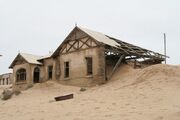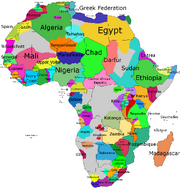(grad) |
(→Former Niger in present times: minor) |
||
| Line 30: | Line 30: | ||
==Former Niger in present times== |
==Former Niger in present times== |
||
| − | |||
When the nation of Niger collapsed, many areas reverted to small Hausa tribal kingdoms based around small farming townships, in the north many towns and cities (particularly the city of Agadez where the population dropped from 250,000 in 1983 to zero in 1999) were totally abandoned to the Sahara sands. |
When the nation of Niger collapsed, many areas reverted to small Hausa tribal kingdoms based around small farming townships, in the north many towns and cities (particularly the city of Agadez where the population dropped from 250,000 in 1983 to zero in 1999) were totally abandoned to the Sahara sands. |
||
| − | The population of the area now is around 1 million, the majority of the remaining population live in the relatively rich farmland in the south of the former nation near the former border with Nigeria. |
+ | The population of the area now is around 1 million, the majority of the remaining population live in the relatively rich farmland in the south of the former nation near the former border with Nigeria. It is largly under Nigeria's subsiquent geo-political and ecanomic infuence. |
[[Category:Defunct countries (1983: Doomsday)]] |
[[Category:Defunct countries (1983: Doomsday)]] |
||
[[Category:Niger]] |
[[Category:Niger]] |
||
Revision as of 05:23, 23 August 2011
Niger (pronuonced Nee-Jair) is a former nation in western Africa.
for Nigeria (1983: Doomsday) see: Nigeria
Pre-Doomsday
After the establishment of the Fifth French Republic on December 4, 1958, Niger became an autonomous state within the French Community. It gained full independence on August 3, 1960.
For its first fourteen years as an independent state, Niger was run by a single-party civilian regime under the presidency of Hamani Diori. In 1974, a combination of devastating drought and accusations of rampant corruption resulted in a coup d'état that overthrew the Diori regime. Col. Seyni Kountché and a small military group ruled the country until Doomsday.
Post Doomsday
It took several hours for news of Doomsday to reach the government of Niger, although no nuclear detonations occurred the effects were still felt across the country. Within months all remaining food aid in the country had been used and the population began to starve.
The military government quickly and brutally clamped down on any demonstrations against the government, thousands were killed, however this made the population more angry and rumors began circulating of massive food stores for the use of the military, government and their families while letting the rest of the people starve.
By the summer of 1984 the nuclear summer had begun to take effect and approximately 80% of the crops in the country failed due to drought. Due to the massive food shortages,and the continued drought, the population of Niger crashed between 1984 and 1989 from just over 6 million to under 1 million
By late 1984 the population were dying due to starvation, however the staff of the government and military still appeared well-fed, fueling more rumors of secret food stores. In the capital city of Niamey, riots broke out in October 1984, many government buildings were ransacked and burned, the military cracked down hard, shooting thousands and many hundreds simply vanishing.
By December 1984 the military government could no longer control the populace, Col. Seyni Kountche and several of his advisers escaped south in Nigeria and disappeared, the military and police disbanded. A temporary government was sworn in however without the support of the military, it fell by January 1985 and the general population were left on their own.
As a country Niger ceased to exist during 1985.
Chaos reigned over the next two years as former police and military units became warlords, however due to the ongoing drought and food shortages even these began to fall by the late 1980's.

Picture of abandoned city of Agadez

Former Niger in present times
When the nation of Niger collapsed, many areas reverted to small Hausa tribal kingdoms based around small farming townships, in the north many towns and cities (particularly the city of Agadez where the population dropped from 250,000 in 1983 to zero in 1999) were totally abandoned to the Sahara sands.
The population of the area now is around 1 million, the majority of the remaining population live in the relatively rich farmland in the south of the former nation near the former border with Nigeria. It is largly under Nigeria's subsiquent geo-political and ecanomic infuence.
